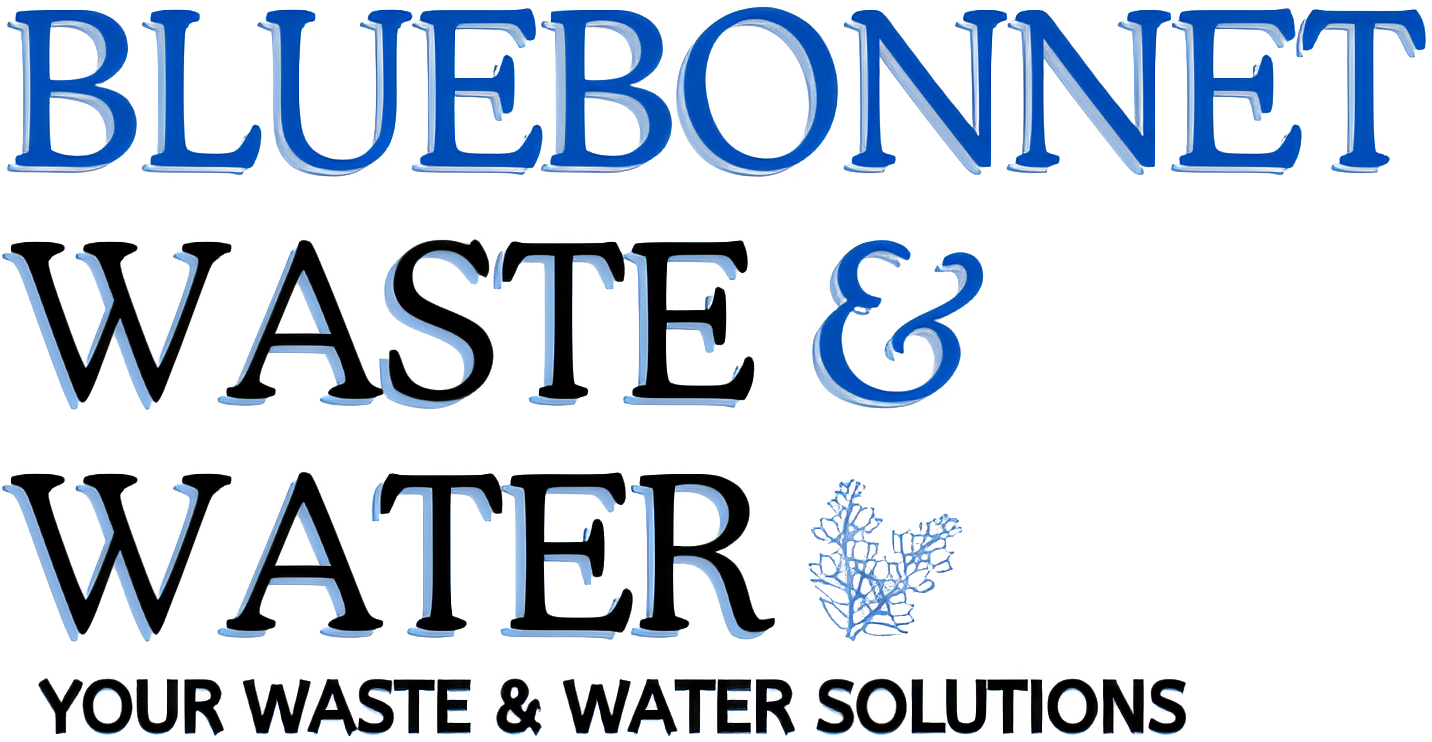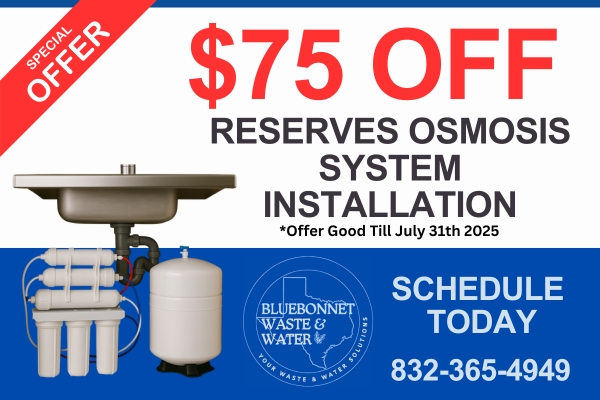
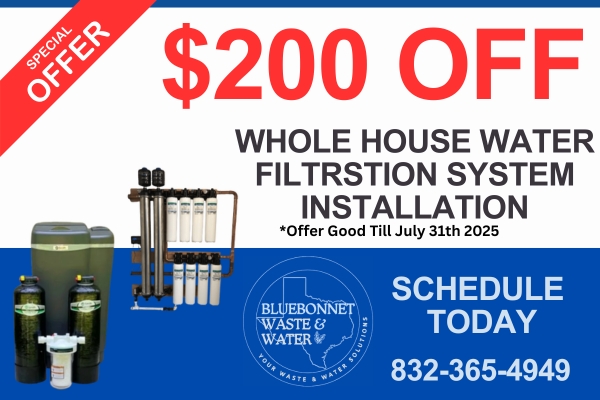
Bluebonnet’s Guide to Water Filtration and Maintenance
For homeowners dealing with hard water, installing a whole house water softener can dramatically improve water quality and extend the life of appliances and plumbing. Hard water, which contains high levels of calcium and magnesium, can lead to scale buildup in pipes, dishwashers, and water heaters, increasing maintenance and reducing efficiency. A water softener not only prevents these issues but also delivers benefits like softer skin, shinier hair, cleaner dishes, and less soap residue throughout the home. Whether you’re upgrading an existing system or considering your first water softener, understanding how these systems work, and which type best suits your household is key to making an informed decision.
Water Filtration And Its Importance In Southeast Texas
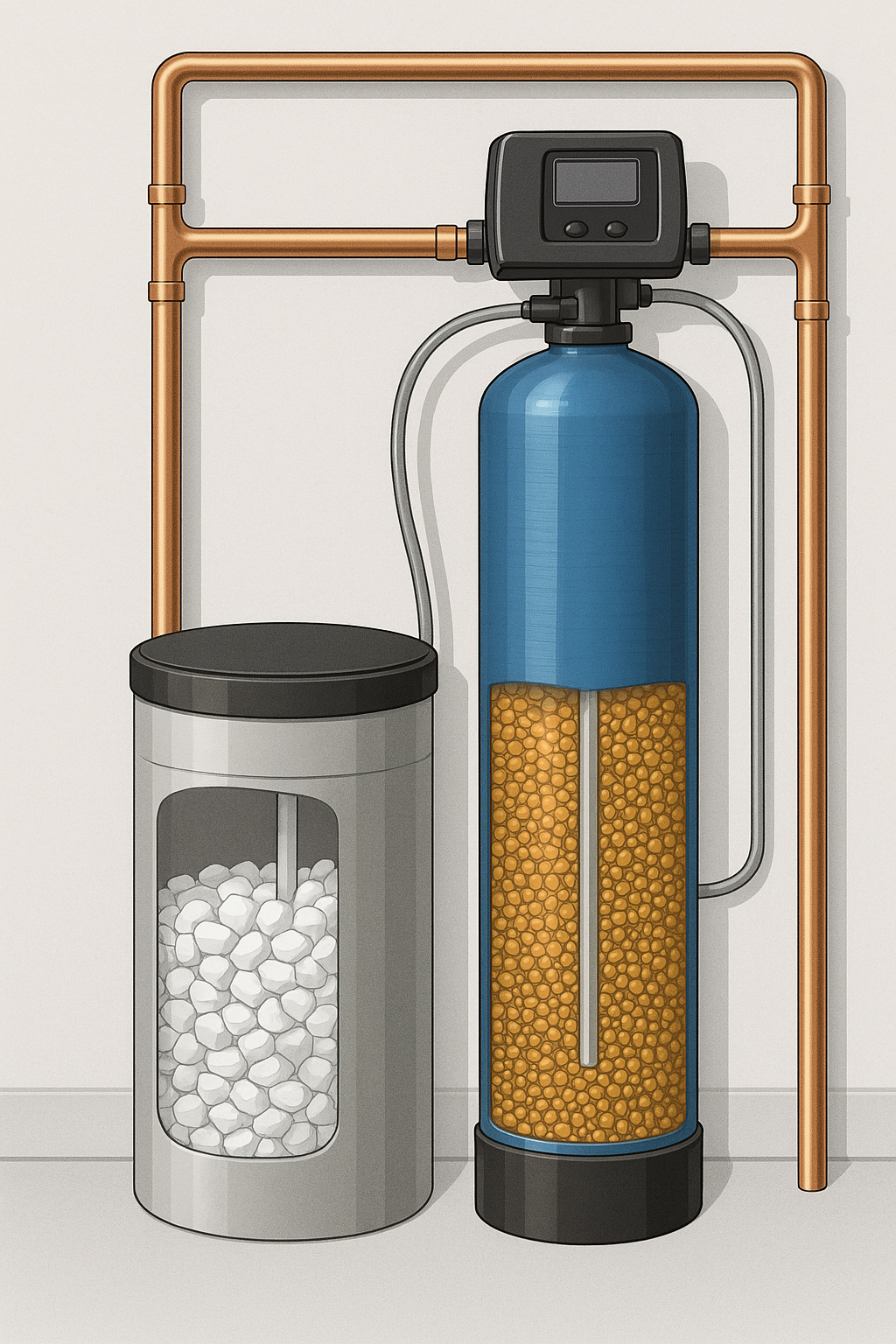
Water filtration is critical in maintaining water quality in Southeast Texas, where the variability between municipal and healthy water can be significant. Municipal water may undergo treatment, but it can still contain sediments or other impurities that affect taste and safety. Conversely, well water often has high mineral content and potential contaminants that necessitate thorough filtration.
Using sediment filters is an essential first step in water treatment. They effectively remove larger particles that can clog pipes and damage appliances. Water softeners address hard water issues by replacing calcium and magnesium ions with sodium or potassium ions, preventing scaling and extending the lifespan of plumbing and appliances.
For those seeking premium drinking water quality, reverse osmosis systems are ideal. They remove contaminants at a molecular level, ensuring clean and safe water for your family. These systems are usually installed at single points of use, such as under kitchen sinks or connected to refrigerators, offering convenience and enhanced water quality right where needed most.
Implementing a combination of these water filtration methods can significantly improve the quality and safety of your home’s water supply, making daily activities more pleasant and ensuring the well-being of your family.
Benefits of Using A Water Softener
Installing a water softener in your home can bring multiple benefits, particularly when dealing with hard water issues. One of the primary advantages is the protection of appliances and plumbing systems. Hard water can cause mineral buildup in pipes and appliances, leading to inefficiencies and eventual breakdowns. A water softener helps extend the life of your appliances by preventing such buildup.
Additionally, softened water results in a noticeable reduction of water stains on dishes and surfaces, improving the overall appearance of your home. This can save you time and effort in cleaning and leave your fixtures looking new. Plus, softer water enhances the quality of showers and laundry, making clothes feel softer and skin more refreshed.
Who should install a water softener? Installing a whole house water softener helps to minimize scale buildup in many appliances, hot water heaters and pipes. Reducing the scale buildup can extend the lifespan of the appliances and reduces the maintenance cost of repairs. If a homeowner has hard water, then installing a water softener will improve the quality of the water which will feel gentler on skin, hair and clothing. Additionally, many customers report that a water softener helps to prevent dryness and soap reside. As a water softener reduces minerals and scale buildup, water from a water softener can improve the effectiveness of soap and detergent performance which leads to cleaner dishes and less soap residue in sinks and showers.
Water softener evaluation. There are several factors to consider when evaluating which water softener to install. First, what is the hardness of the water source. Water hardness levels can vary greatly depending on location and water source. Testing your water to determine your hardness level (measured in grains per gallon or gm/L) should be the first step to determine the capacity of the softener you will need for your household. The more people in the household will cause a higher water demand which results in a higher softener capacity. One important factor to consider when choosing a water softener is a unit that can handle peak usage without frequent regeneration. Bluebonnet technicians can help you choose the best water softener to handle your household loads.
There are typically two types of water softener systems: salt-based and salt-free. Salt based systems are more effective at removing very hardwater due to the ongoing ion exchange process between the resin, magnesium and calcium. However, salt-based systems require more frequent regeneration cycles and regular salt refills. If your water source is less hard, a salt-free system may be the better choice. A salt-free system reduces scale buildup without removing minerals. These systems are better for low hardness levels and have lower maintenance needs.
Best In Class Customer Service
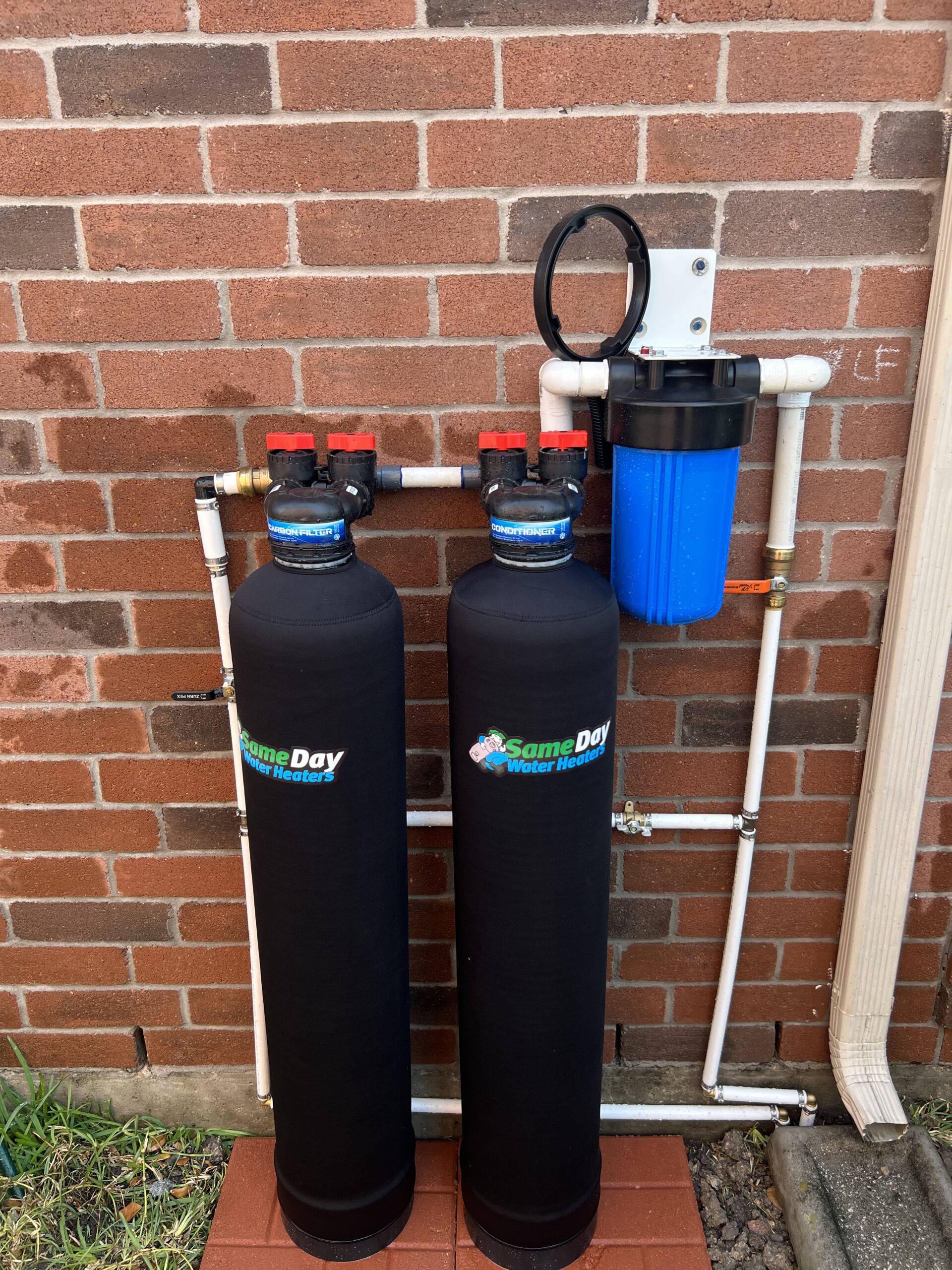
At Bluebonnet Waste & Water Services, exceptional customer service is crucial to our success. From your initial inquiry to the completion of any service, our goal is to provide a seamless, stress-free experience. Our knowledgeable and friendly team is always ready to assist you with any questions or concerns, ensuring you feel informed and confident in your choices.
We understand that every home and water system is unique, so we take the time to assess your specific needs and recommend the most effective solutions. Whether installing a new water softener, upgrading to a reverse osmosis system, or needing routine maintenance, we tailor our services to fit your requirements.
Our commitment to quality doesn’t end with the installation. We offer comprehensive follow-up support to ensure your systems operate at peak performance. Should you encounter any issues, our responsive customer service team is just a call away, ready to promptly address and resolve any problems.
At Bluebonnet Waste & Water Services, we value transparency and honesty. You’ll receive clear, straightforward information about our services, pricing, and what you can expect from our team. We strive to build lasting relationships with our clients, based on trust and mutual respect.
Choosing Bluebonnet means choosing a company that genuinely cares about your well-being and water quality. Our top-notch water filtration and maintenance services help you achieve peace of mind. Your satisfaction is our highest priority, and we are dedicated to exceeding your expectations at every step.
Water Evaluation and Extended Warranty
When evaluating which water softener to install, ensure you are evaluating the warranty and support from the manufacturer and installer. With regular maintenance and care, a water softener should have a lifespan of 10+ years. Bluebonnet Waste and Water are experts in the installation and maintenance of water systems in Magnolia, Tomball, Spring, The Woodlands and Conroe. All new installations have a 2-year warranty and are eligible for our 5 Year Worry Free programs. With Bluebonnet’s 5-Year Worry Free program our technicians service, refill and maintain your water softener so you stay focused on your family and not worrying about your water softener.
When choosing a water softener, it’s essential to evaluate your home’s water hardness, household size, and daily water usage to ensure the system meets your needs without frequent regeneration. Salt-based systems offer maximum effectiveness for high-hardness water, while salt-free models are ideal for lower levels and require less maintenance. It’s also important to distinguish between a water softener, which addresses mineral buildup, and a water filter, which removes contaminants like chlorine, lead, and sediment. With proper installation, regular maintenance, and support from a trusted provider like Bluebonnet Waste and Water, your softener can provide 10+ years of reliable performance. Bluebonnet proudly serves Magnolia, Tomball, Spring, The Woodlands, and Conroe, offering expert guidance, quality installation, and peace of mind through their 2-Year Warranty and 5-Year Worry Free Program.
Frequently Asked Questions
How does a water softener work? Hard water, from the city or a well, enters the water softener tank. The softener tank is filled with resin beads that are chard with sodium or potassium ions. As the hard water flows over and around the resign beads, the positively charged calcium and magnesium ions are attracted to the negative charged resin beads (high school chemistry review: magnesium and calcium have a +2 charge). The positive charged ions stick to the resin and resin releases sodium ions into the water, which results in a softer water. Over time resin becomes saturated with hard minerals. Once the system becomes “full” the system will go into a regeneration mode cycle where the brine solution flushes the minerals from the resign and regards it with sodium so the system can continue softening the water.
Water softener vs water filter? Water softeners are best for households that have hard water issues. Hardwater can be easily tested. If you do not have a testing kit, some telltale signs of hard water are stains on faucets, dishes and shower doors. If you notice scale buildup in water heaters and appliances it is an indication of hard water. If you notice dry skin or dull hair after a shower this could be an indication of hard water, or water that is high in mineral heavy water.
Water filters are best suited for contaminant removal. If you notice a chorine taste or smell or other unpleasant odor, an evaluation needs to be performed to determine if a water filter should be installed. If you are concerned about the sediment, lead or other harmful contaminants than water filter should be installed. Filtration techniques to remove contaminants are activating carbon filtration, reverse osmosis and sediment filtration. See water filtration for more information.
